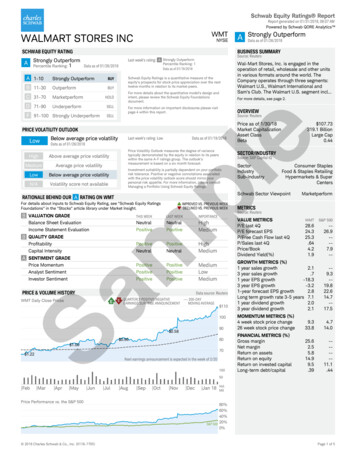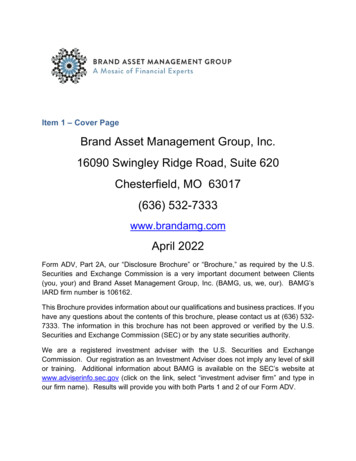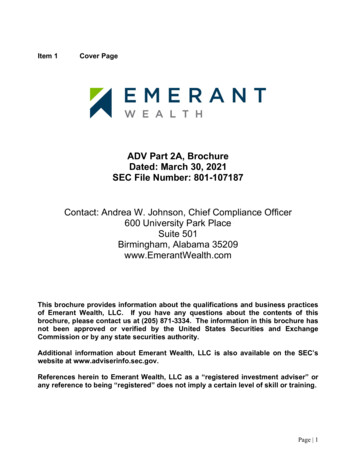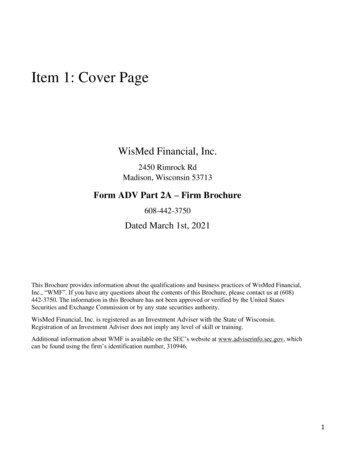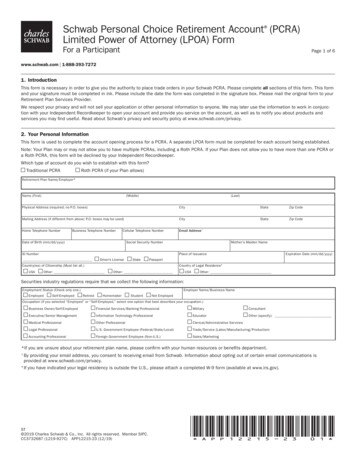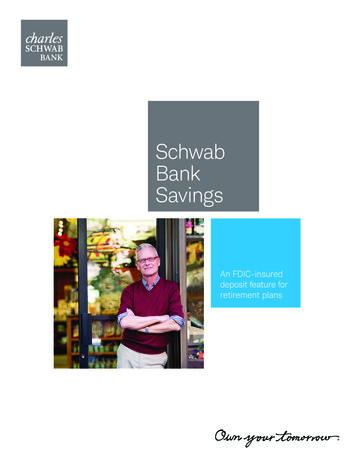
Transcription
SchwabBankSavingsAn FDIC-insureddeposit feature forretirement plans
It’s different from the usual cashpreservation options, with a lotof benefitsIn conversations with our clients, Schwab Bank hasheard that plan sponsors and participants are lookingfor a sense of security when it comes to retirementplan assets. That’s why we offer an FDIC-insureddeposit feature, Schwab Bank Savings,1 as a capitalpreservation option for retirement plan participants.Participants can contribute to Schwab Bank Savingsin an employee benefit plan with up to 250,000 inFederal Deposit Insurance Corporation (FDIC) insuranceprotection on that portion of their account,2 all whileearning interest on the deposit. The balance allocatedto Schwab Bank Savings is deposited in an FDICinsured money market deposit account at CharlesSchwab Bank (“Schwab Bank”). Most participants arefamiliar with FDIC insurance, and they can feel morecomfortable knowing that their bank depositoryholdings are FDIC-insured.When it comes to the goal of “capital preservation,”plan sponsors should consider that providing an FDICinsured product option is one of the best ways to helpensure that a participant’s capital is preserved.FDIC insurance—it just makes senseMany of your employees might be familiarwith the general concepts of FDIC-insuredproducts they can get at a bank. Participantsin self‑directed defined-contribution plans cancontribute to Schwab Bank Savings in their401(k) with up to 250,000 in FDIC insuranceprotection on the Schwab Bank Savings portionof the account, all while earning interest on thedeposit. That’s something most people canunderstand and appreciate.FDIC protection works differently for definedbenefit plans, defined-contribution plans that arenot directed by participants, and other types ofplans. Visit fdic.gov for more information.Key benefitsSchwab Bank Savings is different from many cashpreservation options, with several benefits: No additional expenses.3 Participants do not pay additionaloperating or administrative expenses on funds deposited inSchwab Bank Savings. No MMFR fees and gates. Charles Schwab Bank offers asimplified solution by eliminating exposure to Money MarketFund Reform fees and gates. FDIC insurance. Deposits are insured up to 250,000 whenthe funds are aggregated with all other deposits held bya participant in an individual retirement account or selfdirected employee benefit account. Bank soundness. Charles Schwab Bank has strong liquidity,internal financial controls, and business standards, with afocus on keeping client assets safe.2
Schwab Bank Savings isdifferent from a standardmoney market fundAs capital preservation can be a major componentof a diversified investment strategy, plan sponsorsand advisors are often evaluating money marketmutual funds or stable value funds in a retirementplan’s lineup. Schwab Bank Savings is different. Manymoney market mutual funds seek to preserve thevalue of the participant’s investment at 1.00 pershare. Stable value funds seek to preserve the value ofa participant’s investment at original net asset valueplus accrued earnings. However, it is possible to losemoney by investing in such funds. Unlike SchwabBank Savings, the participant’s principal investmentand any earnings are not insured or guaranteed by theFDIC or any other government agency.Capital preservation is not about chasing yieldSchwab Bank Savings is not intended to produce highyields, and therefore does not carry the inherent riskassociated with investment vehicles that chase higheryields. The intent of Schwab Bank Savings is to providean attractive capital preservation vehicle. Along witha sense of security for participants, it offers a low-cost,low-risk, liquid deposit feature that preserves allocatedfunds at Schwab Bank.4 While the amount of interestpaid will vary over time, Schwab Bank Savings seeks topay a rate that reflects current economic conditions5and that is consistent with a low-risk interest ratebenchmark.You might be evaluating the difference in yieldbetween Schwab Bank Savings and alternativecapital preservation options. As you do, it’simportant to consider that there are no additionaladministrative or operating expenses paid byparticipants on balances in Schwab Bank Savingsthat would reduce the principal they invest.63
The soundness of abank deposit featureis assessed by lookingat the strength of thesponsoring bank’sbalance sheet,capital structure,and liquidity.What to consider whenevaluating Schwab Bank SavingsPlan sponsors and consultants may be accustomedto tracking the yields of a capital preservation vehicleor analyzing underlying holdings in a money marketmutual fund. But the soundness of a bank depositfeature is assessed by looking at the strength of thesponsoring bank’s balance sheet, capital structure,and liquidity. With Schwab Bank Savings, whatshould a plan fiduciary consider?Federal oversightSchwab Bank Savings funds are deposited in CharlesSchwab Bank, one of the top 20 banks in the U.S.,7which is subject to ongoing banking regulatoryoversight and examination by the Department ofthe U.S. Treasury’s Office of the Comptroller of theCurrency (OCC). This regulatory oversight mandatesthat Schwab Bank has: A robust capital planning process Adequate capital reserves and liquidity Effective corporate governance Business recovery plans Management of core business lines to effectivelymanage risks and continue operations throughadverse market conditions and internal stresses4
How Schwab Bank measures upSchwab Bank has excellent liquidity and internalfinancial controls and business standards designedto keep client assets safe. 234.0 billion in balance sheet assets8 15.6 billion in equity capital9 Net income of 3.2 billion in 201810 Capital ratios:11— Tier 1 leverage capital ratio: 7.2% as of 12/31/18(minimum to be well capitalized: 5.0%)— Tier 1 capital ratio: 19.7% as of 12/31/18(minimum to be well capitalized: 8.0%)— Total capital ratio: 19.7% as of 12/31/18(minimum to be well capitalized: 10.0%)Our commitmentLast but not least, Schwab Bank is financially strong,and you can have confidence in its disciplined focuson risk management. Its capital structure and liquidityare sound and positioned for long-term strengthand stability.12As a plan sponsor, you can feel confidentoffering Schwab Bank Savings to your retirementplan participants.CharlesSchwab Bank isone of the top20 U.S. banks intotal assets.5
FDIC insurance—a significant benefitWhile banking oversight can provide participantsa sense of security as they invest in SchwabBank Savings, FDIC insurance provides a layer ofprotection. In the unlikely event of a bank failure,every dollar a participant deposits in retirementsavings at Schwab Bank, up to 250,000 based onaccount ownership type, is insured by the FDIC.13The FDIC is an independent agency of the U.S.government. The FDIC protects bank depositorsif an FDIC-insured bank or savings associationfails. The FDIC does not insure money investedin stocks, bonds, mutual funds, life insurancepolicies, annuities, or municipal securities,even if these investments were bought from aninsured bank. It is also important to note that theFDIC insurance limit of 250,000 applies to theaggregate of all deposits held by an individual ata given bank.14Every dollar aparticipant depositsin retirement savingsat Schwab Bank,up to 250,000based on accountownership type, isinsured by the FDIC.With Schwab Bank Savings, participants do nothave an individual bank account with SchwabBank, but rather a beneficial interest in the plan’smoney market deposit account. FDIC regulationspermit the bank to “pass through”15 the benefitsof FDIC insurance to participants because ofthe account titling and recordkeeping thatSchwab Bank’s Business Trust Division and yourrecordkeeper provide. Keeping the proper recordsto ensure FDIC pass-through to participants is theplan sponsor’s responsibility, with support fromthe recordkeeper.Your recordkeeper supplies the required reporting16on behalf of the plan sponsor to Schwab Bank,maintaining records of each participant’s balancedaily, along with the interest earned that has notyet been paid. In the unlikely event that federaldeposit insurance payments become necessary,payments of principal and unpaid interest willbe made to the plan’s trust and reflected inparticipants’ accounts maintained on your behalfby your recordkeeper, subject to the FDICaggregation rules.17For more information about FDIC coverage,go to fdic.gov.6
Cost structureOER vs. spreadUnlike they do with other capital preservation vehicles,participants do not explicitly pay any operating oradministrative expenses—which normally reducea vehicle’s yield—on their funds invested in SchwabBank Savings.Instead, Schwab Bank pays a fee to the FDIC toinsure balances and absorbs the operating expensesto administer and service those balances. SchwabBank also bears the investment risks and cost ofreserving capital. Considering these specific expensesassociated with providing insurance on deposits,the cost structure behind Schwab Bank Savings isdifferent from that of a money market mutual fundor stable value fund, which are not FDIC-insuredand therefore not subject to the same consumerprotection regulations and associated costs.Instead of a stated operating expense ratio (OER),Schwab Bank’s compensation comes from the “spread”that represents the difference between what the bankearns from investing and funding lending activitieswith Schwab Bank Savings balances and the interestrate it pays participants (plus any other expensesabsorbed on these accounts).Our shared goal:Putting the participant firstIt’s important for plan sponsors to offer theirparticipants a retirement plan lineup that can helpmeet their retirement goals. You can offer a capitalpreservation option that does just that—by preservingcapital by placing it in a deposit vehicle with FDICinsurance, not chasing yield. And participantsthemselves can feel more secure knowing that theirSchwab Bank Savings deposits—up to the maximuminsurable limit—are FDIC-insured.Some participants may find that they’re notcomfortable with the levels of risk inherent inmutual funds and exchange-traded funds. At the endof the day, our focus has to be on better retirementoutcomes for participants. Schwab Bank Savingsis one of many innovations we’re making to provideparticipants with choices that empower them to helpreach better outcomes for themselves andtheir families.Since Schwab Bank bears the investment riskassociated with Schwab Bank Savings, rather thanthe participant, the interest rate is lower and is notintended to compete directly with other investmentoptions that involve participant market risk.Let’s continuethe discussion.To learn more about how youcan benefit from an FDIC-insureddeposit feature, contact your servicerepresentative or Schwab RetirementSolutions at 877-702-6498.7
1.Funds allocated to Schwab Bank Savings are deposited in a money market deposit account(MMDA) at Charles Schwab Bank (“Schwab Bank”). An MMDA is a type of savings deposit.2.FDIC Coverage: Funds deposited in the MMDA at Charles Schwab Bank are insured by theFederal Deposit Insurance Corporation (FDIC) up to 250,000 when aggregated with allother deposits held by a Plan Participant in the same capacity at Schwab Bank. Participantsare responsible for monitoring the total amount of deposits that they hold with SchwabBank, in order to determine the extent of deposit insurance coverage available to them ontheir deposits, including the MMDA.3.An interest rate spread applies. See the ‘Cost Structure’ section for additional information.4.Participants may generally move funds into and out of the savings account at any time;however, federal regulations require Schwab Bank to reserve the right to require seven (7)days’ prior notice before allowing a withdrawal or transfer of funds from the savings account.Schwab Bank currently does not exercise this right and has not exercised it in the past.5.Interest will compound daily and be credited to a participant’s balance in Schwab BankSavings monthly. Participants will not earn interest on cash pending trades (cash float).The interest rate will be effective from the day following the last Business Day of the monthuntil the last Business Day of the following calendar month. A “Business Day” shall meanany day on which both Charles Schwab Bank and the New York Stock Exchange are openfor business.6.See note 3 above.7.“Largest 50 Institutions by Consolidated Banking Assets,” American Bankers Association, Q42017; Charles Schwab Bank ranks #13.8.Schedule RC of the 12/31/18 Call Report for Charles Schwab Bank.9.Schedule RI-A of the 12/31/18 Call Report for Charles Schwab Bank.10. Schedule RI of the 12/31/18 Call Report for Charles Schwab Bank.11. Schedule RC-R of the 12/31/18 Call Report for Charles Schwab Bank.12. For the latest information and to learn more about The Charles Schwab Corporation’sfinancial strength, visit aboutschwab.com. The Charles Schwab Corporation (“Schwab”)provides services to retirement and other benefit plans and participants as well as equitycompensation plan services and other financial and retirement services to corporationsand executives through its subsidiaries, Schwab Retirement Plan Services, Inc.; SchwabRetirement Plan Services Company; Charles Schwab Bank; Schwab RetirementTechnologies, Inc. (Schwab RT); and Charles Schwab & Co., Inc. Schwab Advisor Servicesserves independent investment advisors and includes the custody, trading, and supportservices of Charles Schwab & Co., Inc. Schwab Retirement Plan Services, Inc. and SchwabRetirement Plan Services Company provide recordkeeping and related services with respectto retirement plans. Trust, custody, deposit, and lending products and services are offeredby Charles Schwab Bank. Schwab RT is engaged in developing and licensing proprietaryretirement plan recordkeeping systems to independent third-party administrators.Brokerage products and services are offered by Charles Schwab & Co., Inc.13. The portion of Participant accounts allocated to SBS is eligible for Federal DepositInsurance Corporation (“FDIC”) insurance up to 250,000, subject to FDIC rules concerningaggregation of deposit accounts Participants hold in the same capacity with SchwabBank. Participants are responsible for monitoring the total amount of deposits that theyhold with Schwab Bank in self-directed retirement accounts, either directly or through anintermediary such as Charles Schwab & Co., Inc., in order to determine the extent of depositinsurance coverage available to them.14. Under FDIC regulations, an individual’s interest in the deposits of one bank held by thefollowing types of retirement plans and accounts will be aggregated for the purposes of the 250,000 deposit insurance limit: all types of IRAs, all Section 457 deferred compensationplan accounts (such as eligible deferred compensation plans provided by state andlocal governments regardless of whether they are self-directed); self-directed definedcontribution plan accounts (such as self-directed 401(k) plans, self-directed SIMPLE held inthe form of 401(k) plans, self-directed defined contribution money purchase plans, and selfdirected defined contribution profit-sharing plans); and self-directed Keogh plan accountsdesigned for self-employed individuals.15. For more information on FDIC pass-through insurance, refer dic2000part330.14, or contact theFDIC directly.16. For information on the reporting the Plan Sponsor provides to support, please refer to the CharlesSchwab Bank MMDA Agreement.17. There is no specific time period during which the FDIC must make insurance paymentsavailable, and neither the Plan nor Schwab Bank is under any obligation to credit an accountwith funds in advance of payments received from the FDIC. Participants may be required toprovide certain documentation to the FDIC before insurance payments are made.Outcomes are not guaranteed.Trust, custody, and deposit products and services are available through Charles Schwab Bank and Charles SchwabTrust Bank, members of FDIC.Schwab Retirement Business Services created this communication for retirement plan sponsors and retirementplan consultants, advisors, and other retirement plan service providers and fiduciaries only. Schwab RetirementBusiness Services is not a fiduciary to retirement plans or participants and only provides recordkeeping andrelated services.Schwab Bank Savings may not be available for use by all plan types, such as 403(b) plans that may invest inmutual funds and annuity products only. Please refer to your plan documents. Other restrictions may apply.The Charles Schwab Corporation provides a full range of brokerage, banking, and financial advisory servicesthrough its operating subsidiaries. Its broker-dealer subsidiary, Charles Schwab & Co., Inc. member SIPC, offersinvestment services and products. Its banking subsidiary, Charles Schwab Bank (member FDIC and an EqualHousing Lender), provides deposit and lending services and products.Investment Products: Not FDIC Insured - No Bank Guarantee - May Lose Value 2019 Charles Schwab Bank. Member FDIC. Equal Housing Lender. All rights reserved.AHA (0419-97L7) MKT85438-02 (05/19)00230959
contribute to Schwab Bank Savings in their 401(k) with up to 250,000 in FDIC insurance protection on the Schwab Bank Savings portion of the account, all while earning interest on the deposit. That's something most people can understand and appreciate. FDIC protection works differently for defined
